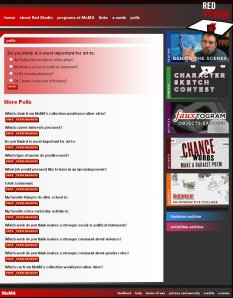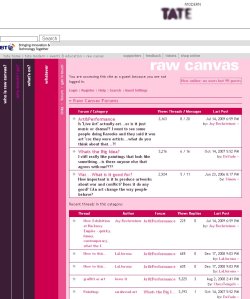DISCOURSE AND COMMUNITY
Regarding discourse and community, Jenkins et al. believe that, “Participatory culture shifts the focus of literacy from one of individual expression to community involvement” (2007, p. 8). MoMA’s Talk Back feature on Red Studio poses statements by artists and a provocative question, then one clicks on the Talk Back button leading to an image by the artist, a space to provide comments (requesting name, city and age) and an interview with the artist, but unfortunately no listing of other comments. There is the option for all users to send e-cards of images from the museum collection, but while the link is in the home page navigation bar, it takes the user away from Red Studio and to the museum website. Part of the value of a public sphere is the formation of public opinion, or in this case, a reading on “teen opinion.” Certainly, the blogs are an excellent way for teens to express themselves in writing, or the podcasts or radio broadcasts in digital media, but a more conventional means is online polling.
Red Studio uses polls that are a combination of personal questions (“Which type of movie do you like most?”) and art-related questions (“Which work do you think makes a stronger comment about violence?”). The public can view the results of all the polls (13 total) as well as vote. The links that a website provides are an important source of information for users, as well as an indication of community affinities. Red Studio also has a Links section that states, “Want to learn more about exhibitions at MoMA? Want to find a museum near you? Research a paper for school? Check out some of these links for more information.” The links are internal to museum collections and projects as well as external to sites related to contemporary art, museums, and teen activities (Teen Ink).Like Red Studio, Tate Kids offers e-cards to send to “friends and family.” The public can leave comments on the Blog as well as in My Gallery, where they can also rate other artwork and send their own artwork in to share with the public. Young Tate offers more opportunities for the teens to interact with the online community in discourse and other means. Artists Online is a blog that focuses on specific artists, where the public can post comments and email images. There is also a Young Tate team, whose 34 members are featured under “Who we are – What we do” on the home page with their name, photo, DOB (date of birth), and personal information such as “favorite art/artist” and “breakfast on Sunday.” The Case Studies post for the Tate Museum described Raw Canvas at the Tate Modern, whose website does an outstanding job at encouraging the online community to participate in conversation in the Forum section, provide opinions and feedback, and to join in free museum events as well as linking to external ones.
The Whitney museum’s Youth2Youth features three significant opportunities for discourse in the section Insights: speakART, Discussion: What is an American? and Cast a Vote. The first presents artwork from the museum collection with a discussion button next to it leading to more information on the artist and artwork, two questions, a space to respond, and an opportunity to view other responses listed only by first name. The second presents a long essay on the non-art related issue about being an American followed by eleven questions, and similarly a space to respond and view other responses. The third is a poll much like Red Studio, but with only two questions, both art-related (“What is art?” and “Who helps artists become famous?”), and the ability to view all the results listed by username. Youth Insights Reviews offers opinions about artworks by program participants (14 from 2004-2005), and while important for the authors, it is closed for public participation. The page states, “One of the most important things Youth Insights teaches is how to speak out about art without feeling shy or needing to apologize for our opinions. We’ve gotten pretty comfortable with thinking and talking about art. So here are some of those opinions:”
Being a public radio station, RadioArte is the most community-focused teen website, and the only one in any other language than English (Spanish).



In the section Events/News, they state, “Upcoming events from Radio Arte’s community calendar. We want to help promote you! Be sure to add your events.” with a link to easily upload event information online. The ways in which they engage the online public in discourse is also distinct from the other websites, choosing to rely more on social networking sites than on polls or discussion sections. Stay Connected on the home page provides links to Flickr, Facebook (566 friends), Twitter (243 followers), and My Space (25,966 profile views). Similarly, at the bottom of the Contact section, Share & Enjoy http://wrte.org/contact/ provides links to Digg, Sphinn, Mixx, del.icio.us, and Google Bookmarks.
The Walker’s WACTAC is the most closed of the teen websites concerning the general online community and opportunities for discourse with the public. There are numerous spaces for the teen council members to discuss art and related matters in the Blogs section, to post notices about activities both at the museum and outside in the sections Events and Links. As mentioned in the Creation and Participation post, WACTAC engages with to the online community of teens to join in museum-related contests, exhibitions, festivals, and councils. It is unfortunate that these open calls are relatively hidden within the site (click on Art section from home page, then a listing of titles under Pages), but perhaps WACTAC intends to reach out more effectively through their Twitter account (although as of September 21, 2009 there were only six followers and 20 following), or interspersed throughout their blog.


Comments are closed.